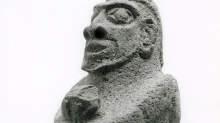
 Sculpture News at SculptSite.com
Sculpture News at SculptSite.com
Sechelt Sculpture Image |
 |
| The Globe and Mail by WENDY STUECK Prehistoric sculpture returned to Sechelt bandSitting with her face turned up to the sky, her child cradled in her arms, the woman known simply as the Sechelt Image on Saturday will come home, reversing a journey taken more than 80 years ago when the stone sculpture was sold for $25 to the Vancouver Museum. The piece, estimated to be up to 3,000 years old, is considered one of the finest pieces of prehistoric sculpture in Canada and is the first artifact to be repatriated to a first nation by the City of Vancouver. For Sechelt band Chief Garry Feschuk, the Sechelt Image is a priceless link between past and present, as well as a symbol of hope and recovery. "The Sechelt Image documents our history," Mr. Feschuck said Friday at the Vancouver Museum, where the sculpture - 51 centimetres tall, 30 centimetres wide and weighing about 32 kilograms - was being readied for transport from Vancouver to Sechelt. "Our elders have been trying since 1976 to have it come back - and now it is." The sculpture is expected to arrive Saturday in Sechelt, where a welcoming ceremony is planned. The piece is to be housed in a museum built on the site of a former residential school. Negotiations about the building and its security provisions were part of the discussions that led up to an agreement to move the item. Talks about repatriating the image went on sporadically for years but moved in to high gear earlier this year, with band members, museum staff and city officials taking part in discussions aimed at returning the image to the Sechelt band. According to band members, the sculpture was discovered by children playing on a riverbank in the early 1920s and sold to the museum, for $25, in 1926. The item is described as a mortuary stone, depicting a mother who threw herself off a cliff after her only son was killed. According to the story, the boy stumbled across a group of people who were going to attack his village, and was killed. The village was not attacked. But his heartbroken mother killed herself, and his father, a carver, sculpted the image. It was shaped from igneous stone, using a technique known as pecking and grinding, which involves roughing an object into shape using a harder rock known as a pecking stone, and then grinding and smoothing it. The repatriation of the Sechelt Image is part of a global trend of museums returning objects to indigenous people or, in some cases, working out agreements to jointly care for artifacts. The Vancouver Museum is currently involved in returning some items to a Maori group in New Zealand. In September, nearly 300 artifacts - including masks, headdresses, blankets and rattles - from the Royal British Columbia Museum and the Canadian Museum of Civilization were returned to a Nisga'a village on the shores of the Nass River in northwestern B.C. And in Alert Bay, a museum showcases masks and other items that were confiscated in years when potlatch ceremonies were deemed illegal and that have since been returned to the community. "Museums have changed a lot - and they are now far more willing to look at where the rightful home for objects is," Nancy Noble, Vancouver Museum CEO, said on Friday. Band members on Friday thanked museum officials for caring for the Sechelt Image for decades. "She has always belonged to the Sechelt people," Ms. Noble said, "and we are glad she is going back." |
 Is this a good story or what? News doesn't always have to be bad! |
More Sculpture News ....
Submit your SCULPTURE NEWS.
It's easy, just send us an e-mail
(click on Submit News in the left menu) with your pertinent information along with images, we'll take care of the rest. Sculpture makes our world a much better place in so many ways!
SculptSite.com, along with Sculptors and their creative genius all helping to bring the beauty and message of Sculpture to a hurried world.

